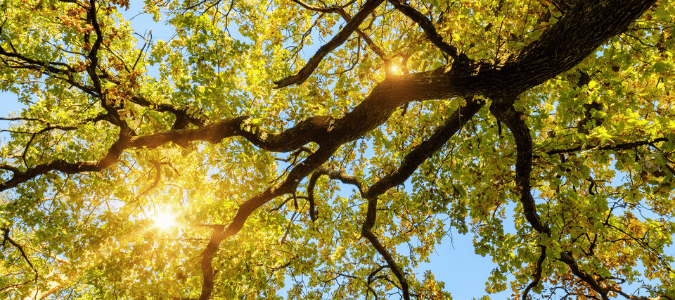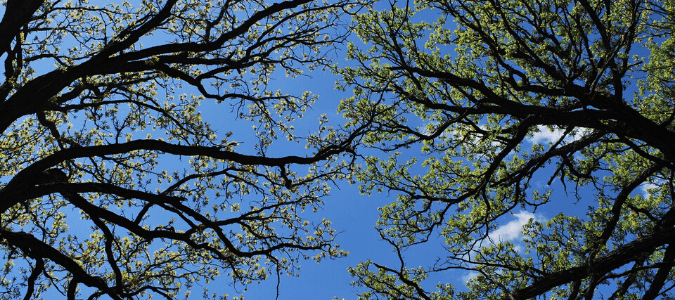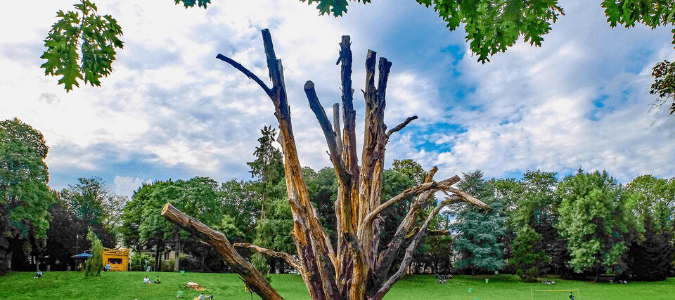
Trees can add great beauty, curb appeal and value to a home, but when their branches grow so long that they begin to scrape against the house or become a falling hazard during a storm, many homeowners want to know how to trim their large trees. There are many benefits of pruning a mature tree, including removing dead or diseased branches, increasing light and airflow to the tree’s inner canopy and reducing the risk of a branch falling and potentially causing harm. Trimming large trees involves working with specialized tools and demanding physical labor, which is why many homeowners have their trees professionally trimmed regularly. If you want to know the steps involved or think you might be up for the job, you’ll want to do your homework.
Here are the basics of how to trim large trees:
- Once you’ve identified a limb that needs to be cut, you would need to make your first of three cuts—a small notch on the underside of the branch, about two to three feet out from the trunk. This is called the notch cut, and it should extend only about a quarter of the way through the branch’s thickness.
- Next, you’d want to cut off the branch just past the notch cut (meaning, between the notch cut and the tip of the branch, not between the notch and the trunk). This is called the relief cut, and its purpose is to remove the bulk of the branch’s weight so the tree won’t split when you make your final and most important cut.
- Finally, the final cut is made by identifying the branch collar—the collar-like bump that forms where a tree branch grows out from the trunk. Many people think they should cut off branches flush to the trunk, but this is not the case. Instead, you want to make your final cut at the point where the collar narrows into the branch itself. Make sure to make a cut that is flush to the natural angle of the collar; if that’s not possible, cut from the bottom up instead of the side or top.
Trimming any tree, and especially a mature one, should always be done with great planning, care and consideration to avoid harming the tree, yourself, someone else or your property in the process. Many people believe tree trimming to be relatively simple, but it’s actually somewhat complex. It’s important to know the aspects of proper tree trimming to ensure that you prune the right limbs, at the right points, in the right manner and during the right season, in order to avoid damaging the tree.
Do-it-yourself tree trimmers also need to know how to exercise proper care to make sure they don’t wind up injuring themselves during the pruning process. Many people don’t realize how dangerous it can be to reach up into a tree’s branches with a long-handled saw until they’re in the middle of pruning and find themselves at risk of cutting themselves with their saw or cutting a branch in such a way that it hits them as it falls to the ground. At this point, you may be starting to see why professional arborists go through extensive training and certification processes to master their trade!
If your tree trimming job is truly a simple one—for example, all you need is to remove a small, dead branch that is located low on the tree—it could be a straightforward enough job to tackle on your own. Before doing so, however, make sure you have the right tools, including a decent tree pruner (which can be found at your local hardware or home improvement store), along with good gloves and safety goggles to protect your eyes and hands. Also, be sure to have a working knowledge of safe ways to cut a tree branch without causing damage to the tree.
It’s important to be extremely mindful of safety—that of yourself, other people, any pets and your property—throughout the pruning process. When making the relief cut, for example, make absolutely sure beforehand that when the branch falls, it won’t hit anything or anyone. Additionally, don’t try to trim limbs you can’t reach from the ground; instead, contact a tree care specialist to handle the higher branches in need of pruning.
Trimming large trees can be done at any time of year if there is a limb that is an obvious fall hazard, but optimally, tree trimming should be done sometime between late fall and early spring. Cutting back limbs before late spring and summer arrive will help the tree bounce back from the cuts as quickly and completely as possible. It’s a good rule of thumb to make it an annual practice to inspect your trees during the early spring, remove any dead limbs and cut branches back from your home, garage and other structures to create several feet of clearance.
Many homeowners wind up hiring an arborist rather than risking their own safety along with their trees’ wellbeing by trying to trim branches themselves. It’s important to make sure to hire a certified tree care specialist, and, if you have oak trees, preferably one who is Oak Wilt Qualified. Someone with this level of knowledge and training can easily handle your tree trimming needs along with all other aspects of tree maintenance. This includes identifying trees that may be struggling due to pests like termites or borers, or diseases such as oak wilt or hypoxylon canker.
There are some differences in how to prune certain types of trees, oaks included. Keep reading to learn more about how to prune your oak trees to keep them healthy.

Helpful Tips for Oak Tree Pruning
There are several types of oak trees that are common throughout the U.S., including live oaks, red oaks and Mexican oaks. If you have oak trees in your landscape and want to make sure they are staying healthy, it’s important to educate yourself about oak wilt. Red oaks are the most susceptible to this serious fungal disease, while white oaks are the least susceptible. Live oaks are somewhere in the middle and Mexican oaks are relatively resistant to wilt. If you have an oak tree that you suspect might be suffering from oak wilt, it is extremely important not to trim its branches without consulting a qualified professional. Cutting branches from a tree with oak wilt at the wrong time of year, or without taking proper precautions, can put you at a higher risk of spreading the disease to nearby healthy trees.
Signs of oak wilt include:
- A reddish tint to the leaves’ vascular tissue
- Black or gray fungal mats on the trunk of the tree
- Wilted or curled leaves
- Dead crowns
Keep in mind that it can be difficult to determine whether your tree has oak wilt or some other condition. If you have any hesitation, contact an Oak Wilt Qualified professional for an evaluation.
It is also important to consider the timing of pruning your oaks. Again, this relates to the risk of oak wilt and other diseases. Rather than pruning oaks in the early spring, which is recommended for many other types of trees, it may be better to prune oak trees in the winter, when they are fully dormant. This will reduce the risk of diseases entering through the open wounds left after trimming. Similarly, it is also wise to clean your pruning tools after each cut with a mixture of water and bleach, to disinfect the cutting surfaces and reduce risk of spreading disease. Lastly, always apply a dressing to fresh wounds after pruning to ensure that your oak tree is protected from diseases and pests.
Note that improper pruning techniques can further weaken oak trees and make them more susceptible to grave diseases. This is yet another reason that people with oak trees should be fully educated about best practices for pruning oaks, or they should hire a knowledgeable and experienced arborist who can trim oaks correctly.
One method of pruning that many homeowners have heard of and inquire about is tree topping.

Tree Topping: Harmful or Beneficial?
Tree topping—also called dehorning, heading, stubbing or crowning—is a pruning practice, usually performed in early spring, that is simultaneously popular and controversial among home gardeners. Popular especially for certain types of ornamental and flowering trees, such as crepe myrtles, tree topping is the practice of cutting off trees’ main trunks and smaller branches at a uniform height. Among tree topping proponents, the practice is intended to serve two main purposes: to keep the trees from growing too tall and to encourage showier blooms.
There are several reasons why many knowledgeable landscapers and home gardeners alike warn against tree topping, starting with the fact that the practice weakens trees’ natural strength and instead encourages the growth of numerous, thinner stems from the newly cut branches. Furthermore, tree topping doesn’t stimulate trees to produce more blooms; in fact, it causes them to produce fewer yet larger blooms, which can be too heavy for the new, thin branches to support.
Another reason to avoid tree topping is the fact that cutting off the tops of trees removes many of their leaves, which are trees’ main source of food. Leaves contain chlorophyll, which interacts with sunlight in a process called photosynthesis to produce food for the whole tree. When a tree’s leaves appear sparse or discolored, some people might think topping the tree will encourage fresh growth, but a far better way to address the problem is to have a certified arborist inspect the tree for disease and recommend steps to help the tree thrive.
Professional arborists can also help with keeping trees trimmed appropriately. Trees should never be topped in order to keep them from growing “too tall” for the space where they were planted. Instead, both taller trees and smaller trees or shrubs should be planted in appropriate spots in your yard that can accommodate their natural height and the spread of their branches over time.
Of course, it’s common for homeowners to have trees that need to be trimmed away from the house or other structures on their property. Fortunately, there are many good ways to prune trees appropriately without drastically topping and potentially damaging them permanently. Additionally, by hiring certified arborists, you won’t need to worry about how to save a dying tree due to improper trimming techniques. These specialists can assist with all aspects of tree care, including pruning and trimming branches and dead limbs, diagnosing tree diseases and recommending types of trees that will thrive in your particular yard or garden space. Having a professional prune your trees as well as help maintain your lawn and plants can ensure your landscape is getting the attention and specialized care it needs to thrive.
ABC Can Keep Your Trees Healthy and Beautiful
It can be difficult to find the time, tools and expertise to keep your trees healthy—even more so if your trees are large. At ABC Home & Commercial Services, we have a team of certified arborists who are here to provide any tree service you may need and specialists that can provide you with a variety of lawn services. We have a deep knowledge of when and how to trim trees so they will be healthy for many years to come.
